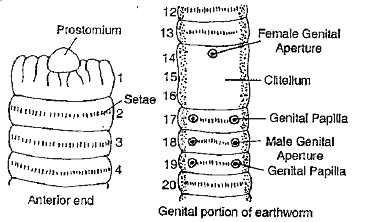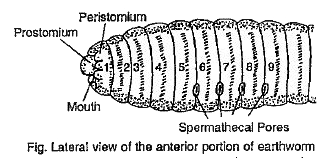Describe external structure of earthworm.
Text Solution
External characters.
Shape, size and colour. An elongated bilaterally symmetrical body. The dorsal surfuce is recognised by a dark line which is in fact dorsal blood vessel beneath the skin. The ventral. surface can be recognised by the presence of genital aperture and papillae. The mature P. posthuma is about 150 mm in length and 3 to 5 mm in width. The colour is glistening dark brown. The dorsal surface is darker than ventral.
Segmentation. The elongated body comprises 100 to 120 segments or metameres which are distinc externally by the circular grooves the annuli. The latter correspond internally as septa to divide the body cavity into compartments. This type of segmentation whicl) is both external and internal, is known as metameric segmentation. The earthworms do not possess a distinct head. The firstsegment oftbe body is termed as peristomium, which bears a fleshy lobe, the prostomium. Clitellum. The clitellum, a prominent circular band of glandular nature, is found from the 14th to 16tb segments. These segments are not distinct externally. The clitellum secretes mucus and albumen. Its secretion helps in the formation of cocoon, which is used for fertilization of the eggs. On the basis of the clitellum, the body of earthworm is divisible into preclitellar, clitellar and post-clitellar regions.
Setae. Except the first, the last and clitellar segments, each segment bears a ring of tiny curved, chitinous structures, known as setae. They are embedded in the skin. Each. seta develops from a

setal sac, which is a small pit in tbe skin. The pale yellow seta is somewhat curved .S. shaped with a swollen middle. portion, the nodulus. The part of the seta present in the setal sac is known as base, that projecting out is called neck and middle part is called nodulus. The setae are directed backwardly, and hold the substratum firmly. Thus, tbey help in the locomotion. The movements of the setae are controlled by the special types of muscles.
(i) Mouth. The peristomium encloses a crescent shaped mouth on its anterior end. It is overhung by tl)e fleshy prostomium. The mouth is used in the feeding.
(ii) Anus. It is a vertical slit like terminal opening, situated in tbe last of anal segment. It passes out the indigestible food matter.
(iii) Female genital aperture. It is a single aperture, situated on tbe ventral side of the 14th segment. The ova are passed out by this aperture.

(iv) Male genital apertures. These are a pair of crescentic openings, lying on the ventral side of the I8th segment. Male reproductive fluid containing sperms is discharged by tbese apertures.
(v) Spermathecal pores. There are four pairs of small openings situated ventro-Iaterally in the intersegmental grooves of the segments 5/6, 617, 7/8 and 8/9 on each side. Each opening leads into a spermatheca, in which the sperms of the other earthworm are stored.
(vi) Nephridiopores. These are numerous, minute openings, scattered irregularly all over the body surface, except the first two segments. The nephridiopores are the openings of the integumentary nephridia to expel out the nitrogenous wastes from the body.

(vii) Dorsal pores. These are minute openings, lying on the mid-dorsal line in the intersegmental grooves, behind the 12th segment. The first dorsal pore is situated in between 12th and 13th segmental grooves. Other dorsal pores lie in each of the succeeding intersegmental grooves, except the last. The body cavity or coelom opens outside by these pores to discharge its coelomic fluid. The fluid keeps the body surface smooth and moist, and also protects the animals from the harmful bacteria.
(viii) Genital papillae. These are two pairs of rounded, prominent outgrowths, present on the ventral side of the 17th and 19th segments. Beneath each genital papilla there is present an accessory gland. Each accessory gland opens to the exterior by a number of fine apertures on the genital papilla. The secretions secreted by the accessory glands comes out through fine apertures to help in keeping the two worms together during copulation.
|
Updated on:21/07/2023
Similar Questions
Name the excretory structures of earthworm.
View SolutionName the excretory structures of earthworm.
View SolutionList a few important external features of earthworm.
View SolutionGive an account of the external characters of earthworm.
View SolutionDescribe structure of a chromosome.
View SolutionDescribe the external features of the head or thorax of cockroach.
View SolutionDescribe the structure of a biogas plant.
View Solutiondescribe the basis structure of chromosomes.
View SolutionExternal Structure OF Heart || Ischemic Heart Disease || Internal Structure OF Heart
View SolutionStudy of external structure and their form is called (1) Morphology (2) Anatomy (3) Ecology (4) Phycology
View Solution

